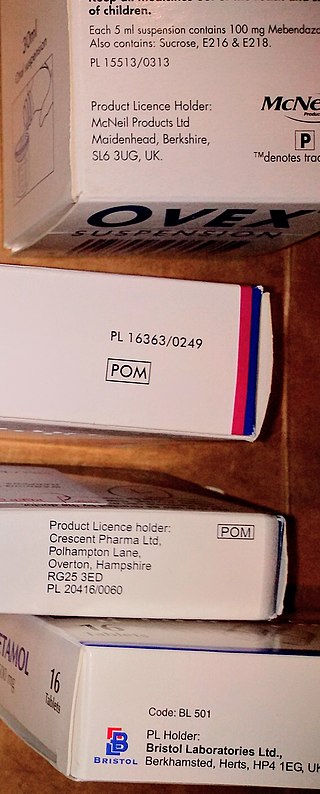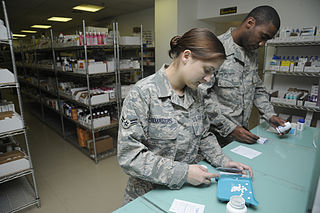Related Research Articles

A medication is a drug used to diagnose, cure, treat, or prevent disease. Drug therapy (pharmacotherapy) is an important part of the medical field and relies on the science of pharmacology for continual advancement and on pharmacy for appropriate management.

A pharmacist, also known as a chemist in Commonwealth English, is a healthcare professional who specializes in the preparation, dispensing, and management of medications. A pharmacist provides pharmaceutical advice and guidance, often serving as a primary care provider in the community, and offering other services, such as health screenings and immunizations.

Pharmacy is the science and practice of discovering, producing, preparing, dispensing, reviewing and monitoring medications, aiming to ensure the safe, effective, and affordable use of medicines. It is a miscellaneous science as it links health sciences with pharmaceutical sciences and natural sciences. The professional practice is becoming more clinically oriented as most of the drugs are now manufactured by pharmaceutical industries. Based on the setting, pharmacy practice is either classified as community or institutional pharmacy. Providing direct patient care in the community of institutional pharmacies is considered clinical pharmacy.

A prescription, often abbreviated ℞ or Rx, is a formal communication from a physician or other registered healthcare professional to a pharmacist, authorizing them to dispense a specific prescription drug for a specific patient. Historically, it was a physician's instruction to an apothecary listing the materials to be compounded into a treatment—the symbol ℞ comes from the first word of a medieval prescription, Latin recipere, that gave the list of the materials to be compounded.

A prescription drug is a pharmaceutical drug that is permitted to be dispensed only to those with a medical prescription. In contrast, over-the-counter drugs can be obtained without a prescription. The reason for this difference in substance control is the potential scope of misuse, from drug abuse to practicing medicine without a license and without sufficient education. Different jurisdictions have different definitions of what constitutes a prescription drug.
The Royal Pharmaceutical Society of Great Britain (RPSGB) existed from its founding as the Pharmaceutical Society of Great Britain in 1841 until 2010. The word "Royal" was added to its name in 1988. It was the statutory regulatory and professional body for pharmacists and pharmacy technicians in England, Scotland and Wales. In September 2010, the regulatory powers of the Society were transferred to the newly formed General Pharmaceutical Council (GPhC). The RPSGB became the Royal Pharmaceutical Society (RPS) at that time and retained its professional leadership role; the "Great Britain" part of the name was dropped for day-to-day purposes.
A Doctor of Pharmacy is a professional doctorate degree. In some countries, it is a proficient graduate degree to practice the profession of pharmacy or to become a clinical pharmacist. In many countries, people with their Doctor of Pharmacy are allowed to practice independently and can prescribe over-the-counter drugs directly to patients that doesn't require prescription in other countries. A PharmD program has significant experiential and/or clinical education components in introductory and advanced levels for the safe and effective use of drugs. Experiential education prepares graduates to be practice-ready, as they already have spent a significant amount of time training in areas of direct patient care and research.

The regulation of therapeutic goods, defined as drugs and therapeutic devices, varies by jurisdiction. In some countries, such as the United States, they are regulated at the national level by a single agency. In other jurisdictions they are regulated at the state level, or at both state and national levels by various bodies, as in Australia.

A pharmacy technician performs pharmacy-related functions. Training, certification, licensing, and actual practice of pharmacy technicians varies not only worldwide but in some countries regionally as well as by employer.
An independent pharmacy is a retail pharmacy that is not directly affiliated with any chain of pharmacies and is not owned by a publicly traded company. Independent pharmacies are pharmacist-owned, privately held businesses in varying practice settings. They include single-store operations, pharmacist-owned multiple store locations, franchise, compounding, long-term care (LTC), specialty, and supermarket pharmacy operation. Independent pharmacy owners generally have more flexibility to build personalized customer relationships and they strive to differentiate their services from big-chain corporations.

A hospital pharmacy is a department within a hospital that prepares, compounds, stocks and dispenses inpatient medications. Hospital pharmacies usually stock a larger range of medications, including more specialized and investigational medications, than would be feasible in the community setting. Hospital pharmacies may also dispense over-the-counter and prescription medications to outpatients.

In the field of pharmacy, compounding is preparation of custom medications to fit unique needs of patients that cannot be met with mass-produced products. This may be done, for example, to provide medication in a form easier for a given patient to ingest, or to avoid a non-active ingredient a patient is allergic to, or to provide an exact dose that isn't otherwise available. This kind of patient-specific compounding, according to a prescriber's specifications, is referred to as "traditional" compounding. The nature of patient need for such customization can range from absolute necessity to individual optimality to even preference.

The Medicines Act 1968 is an act of Parliament of the United Kingdom. Its official long title is "An Act to make new provision with respect to medicinal products and related matters, and for purposes connected therewith." It governs the control of medicines for human use and for veterinary use, which includes the manufacture and supply of medicines, and the manufacture and supply of (medicated) animal feeding stuffs.

Clinical pharmacy is the branch of pharmacy in which clinical pharmacists provide direct patient care that optimizes the use of medication and promotes health, wellness, and disease prevention. Clinical pharmacists care for patients in all health care settings but the clinical pharmacy movement initially began inside hospitals and clinics. Clinical pharmacists often work in collaboration with physicians, physician assistants, nurse practitioners, and other healthcare professionals. Clinical pharmacists can enter into a formal collaborative practice agreement with another healthcare provider, generally one or more physicians, that allows pharmacists to prescribe medications and order laboratory tests.
In Denmark, pharmaconomists are experts in pharmaceuticals who have trained with a 3-year tertiary degree. Pharmaconomy describes either their professional practice or their training courses.
Pharmacy in China involves the activities engaged in the preparation, standardization and dispensing of drugs, and its scope includes the cultivation of plants that are used as drugs, the synthesis of chemical compounds of medicinal value, and the analysis of medicinal agents. Pharmacists in China are responsible for the preparation of the dosage forms of drugs, such as tablets, capsules, and sterile solutions for injection. They compound physicians', dentists', and veterinarians' prescriptions for drugs. Pharmacological activities are also closely related to pharmacy in China.

A pharmacy is a retail shop which provides pharmaceutical drugs, among other products. At the pharmacy, a pharmacist oversees the fulfillment of medical prescriptions and is available to counsel patients about prescription and over-the-counter drugs or about health problems and wellness issues. A typical pharmacy would be in the commercial area of a community.
Pharmacy automation involves the mechanical processes of handling and distributing medications. Any pharmacy task may be involved, including counting small objects ; measuring and mixing powders and liquids for compounding; tracking and updating customer information in databases ; and inventory management. This article focuses on the changes that have taken place in the local, or community pharmacy since the 1960s.

Drug packaging is process of packing pharmaceutical preparations for distribution, and the physical packaging in which they are stored. It involves all of the operations from production through drug distribution channels to the end consumer.
Pharmacy in the United Kingdom has been an integral part of the National Health Service since it was established in 1948. Unlike the rest of the NHS, pharmacies are largely privately provided apart from those in hospitals, and even these are now often privately run.
References
- ↑ "Veterinary Pharmacy: Just a Spoonful of Sugar". Medscape Today. 2006. Retrieved 2007-04-20.
- ↑ Kayne, SB & Jepson, MH (2004). Veterinary Pharmacy. London: Pharmaceutical Press. ISBN 0-85369-534-2.
- 1 2 3 4 5 Ceresia ML, Fasser CE, Rush JE, Scheife RT, Orcutt CJ, Michalski DL, Mazan MR, Dorsey MT, Bernardi SP (February 2009). "The role and education of the veterinary pharmacist". American Journal of Pharmaceutical Education. 73 (1): 16. doi:10.5688/aj730116. PMC 2690882 . PMID 19513154.
- 1 2 3 Davidson G (January 2017). "Veterinary Compounding: Regulation, Challenges, and Resources". Pharmaceutics. 9 (1): 5. doi: 10.3390/pharmaceutics9010005 . PMC 5374371 . PMID 28075379.
- 1 2 3 Magnifico TA, King AM (May 2017). "Understanding the Veterinary Patient". Pharmacy Times. Retrieved 2018-02-12.
- 1 2 Theberge CR, Sehgal I (June 2016). "Bringing More Veterinary Pharmacy into the Pharmacy Curriculum". American Journal of Pharmaceutical Education. 80 (5): 89. doi:10.5688/ajpe80589. PMC 4937984 . PMID 27402992.
- ↑ Fingleton, Jim (August 2004). "LEGISLATION FOR VETERINARY DRUGS CONTROL" (PDF). No. FAO LEGAL PAPERS ONLINE #38. e Food and Agriculture Organization of the United Nations.
- ↑ "Guidance - Legal controls on veterinary medicines". Crown copyright OGL3. Veterinary Medicines Directorate. 11 July 2018.
- ↑ "Controls on veterinary medicines". National Office of Animal Health Ltd. May 2016.
- ↑ "Suitably Qualified Persons (SQPs) Code of Practice" (PDF). Issued by the Secretary of State for the Department for Environment, Food and Rural Affairs under the Veterinary Medicines Regulations. Crown copyright. Veterinary Medicines Directorate. April 2017.
{{cite news}}: CS1 maint: others (link) - 1 2 3 "Careers in Veterinary Pharmacy". The Society of Veterinary Hospital Pharmacists. Retrieved 2018-02-21.
- ↑ "Veterinary Pharmacy Resident Q&A". Pharmacy Times. April 2015. Retrieved 2018-02-21.
- 1 2 Frankel G, Kusno A, Louizos C (March 2016). "Five things every community pharmacist should know when dispensing for 4-legged patients". Canadian Pharmacists Journal. 149 (2): 99–106. doi:10.1177/1715163516628543. PMC 4813516 . PMID 27076821.
- 1 2 3 4 O'Driscoll NH, Labovitiadi O, Lamb AJ (September 2015). "Evaluation of the practice of veterinary pharmacy". Currents in Pharmacy Teaching and Learning. 7 (5): 606–613. doi:10.1016/j.cptl.2015.06.017. hdl: 10059/1402 .
- ↑ "Launching the VPA". The Veterinary Pharmacy Association. Retrieved 3 April 2021.
- Kayne SB (ed) Introduction to Veterinary Medicine for Pharmacists and SQPs. Glasgow: Saltire Books, 2011
- VPA. What you should know about....Selling Veterinary Medicines. VPA/Riverclyde Books, 2014